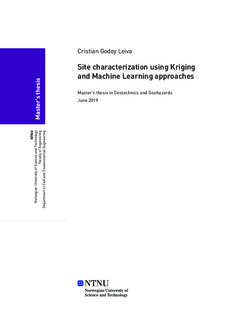| dc.description.abstract | Site characterization has a great number of uncertainties associated with the nature of soil formation and deposition, but also due to technical and economic constraints. In geotechnical practice, these uncertainties have to be addressed in order to perform the most optimum design possible. In this scenario, statistical approaches can be useful to help engineers to gain a better insight into the soil properties and the uncertainties associated.
This master thesis focuses on using two statistical approaches to solve a major challenge faced in geotechnical site characterization: data availability. The first approach is the geostatistical interpolation of soil properties, in which a certain soil property is estimated based on measurements in different locations and the spatial relationship between data. The second approach is machine learning classification and is used to determine the soil types present on the field based on indirect measurements.
Geostatistical interpolation was performed on a slope located in Rissa, which has been studied deeply in previous works, five different CPTu test measurements were used to estimate the properties values in unsampled locations within the slope. The results show a good agreement between the properties distributions and the layering proposed for the site.
Machine learning classification was used to determine the soil classes present on two different sites based on CPTu tests measurements. The sites studied are the NGTS investigation site at Tiller, and the Skaudal bridge foundations site part of a Statens Vegvesen project. The results show a very good capacity of prediction using these algorithms compared with chart classifications commonly used in engineering practise.
Finally, it is always better for design purposes to have additional information whether it be as more field tests to cover the entire area or more laboratory tests to certainly know the properties of the soil beneath the surface. Since resources are rarely enough to fulfill all the engineering necessities, the use of the statistical approaches studied within the framework of this thesis can help engineers to improve the interpretation of field tests without increasing exploration costs. | |
